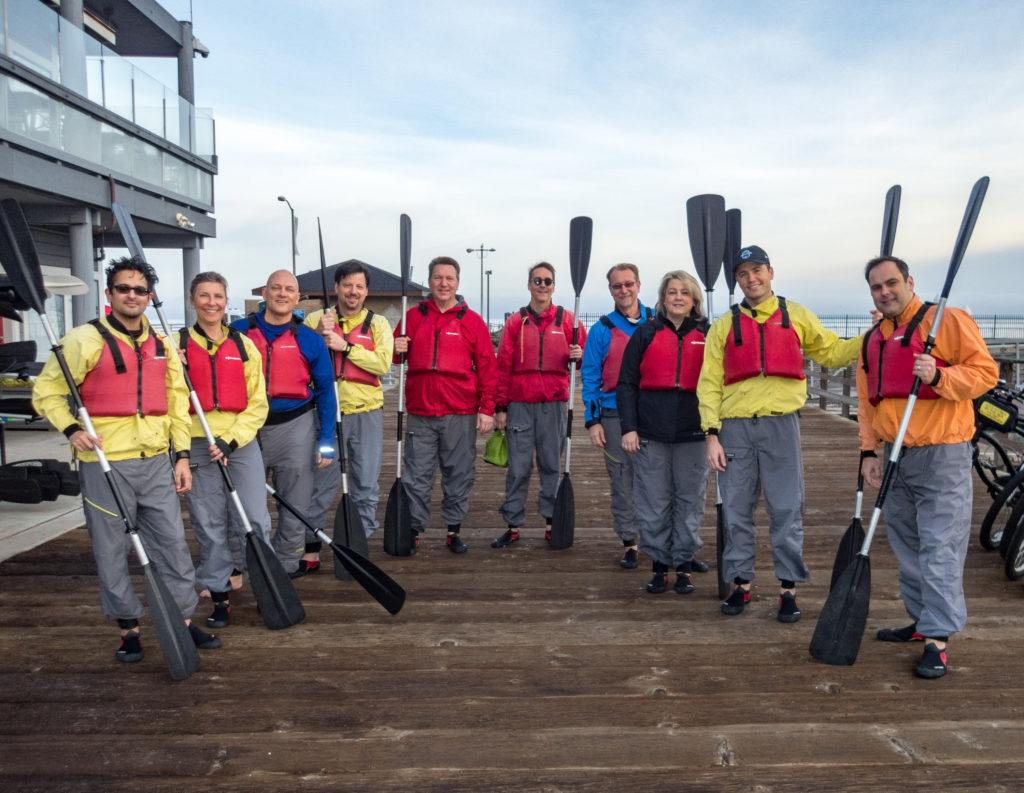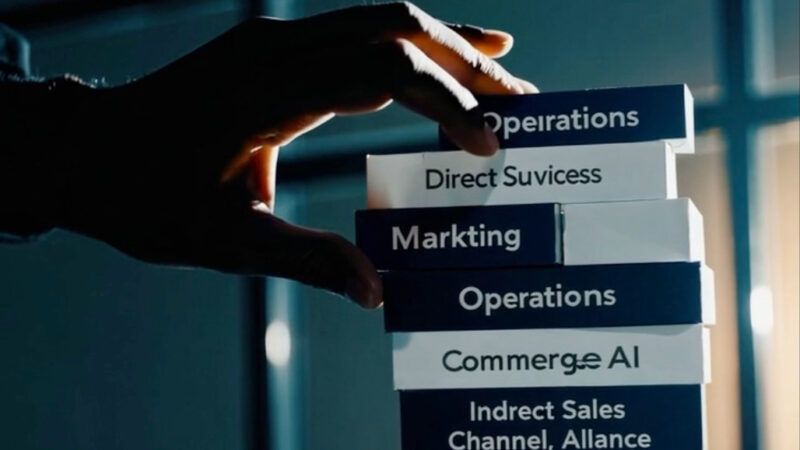Organizational Strategy
Profitable Growth was our 2018 theme supported by four quarterly themes. Early on, I predicted that if we were going to make any fundamental changes in the organization this year, that they would have to be made by Q1. Otherwise, achieving our year-end 2018 goals (e.g. break-even) would be impossible (e.g. we had increased our R&D investments by 50% which put additional pressure on our plan already). Our four quarterly themes were:
- Q1 Organizational Strategy: launching new organizational changes to support growth in 2018. If any optimization is required, Q1 is our only opportunity.
- Q2 Market Development: demand-gen needs to be perfected by delivering on the outcome of our renewed messaging project, achieving all our sales development goals, and executing on our industry vertical and persona content development.
- Q3 Talent Acquisition: achieve all hires for 2018, and prepare for 2019 with recruiting/onboarding and outsourcing readiness (supporting a partner-centric 2019 with the theme of Hyper-Growth with Ecosystem Collaboration will require some deeper planning in Q3).
- Q4 Break Even Operations: getting to a cashflow breakeven by achieving target customer acquisition costs, customer renewal costs targets, and hitting our overall revenue goals.
Strategy drives Organizational Structure (Qtr 8 out of 11)
It was an exciting start to 2018 to say the least. I sent a January 3rd, 2018 email to the entire company ahead of my all-hands that day announcing not one, but seven senior team changes that would lock in the year. It was a bold move, but one I had thought about considerably during Q4. I felt strongly about our strategy, which is what gave me the resolve to making so many changes at once. I knew we had one shot at hitting our 2018 goals. Changes included:
- Larry Drebes steps into a “Founder” role only: This recognized the fact that Larry was continuing his role at Janrain but in a limited capacity, as well as recognizing the fact that Darryl’s leadership since early 2016 warranted the honor of inheriting the CTO title. Strategy = keep founder involved, hold onto the cultural assets that represents, but rely on new leadership to steer the ship.
- Darryl Nicholson, VP of Engineering, adds CTO title: I asked that Darryl form a team of architects in anticipation of his taking on this new role, leveraging that talent to further define our technology strategy in 2018 and beyond. It became our “CTO office”. Secondly, Darryl and I promised each other a year before, that he would relinquish his “COO” responsibilities over Customer Success and Professional Services, to focus on engineering. Strategy = drive quality into our platform and field operations by having strong architectural support (required activating the CTO role).
- Martijn Loderus gets promoted to VP of Solution Engineering & Services : I promoted a Director of PS to the VP role and combined both Professional Services and Solution Engineering into one field engineering organization. This provides Janrain the exciting opportunity to unite both in-field solution engineering with in-field implementation and advisory professional services. These critical pre-sales and post-sales services are now apart of one organization and leadership team, which will provide our enterprise customers a seamless transition as they move from prospects to clients. Strategy = make sure the customer feels nothing disjoint moving from pre to post-sales implementation, and make implementations repeatable and easier (required a seamless handoff between SEs and PS – thus combining the orgs).
- Alan Elliot becomes VP of Global Revenue: growing efficient, predictable, revenue faster required both protecting and activating our base of existing customers, as well as selling into new customers more efficiently. I asked Alan to assume the responsibilities over both our Customer Success organization (responsible for both renewals and expansion business), while continuing his leadership with our sales team (responsible for both new logos and expansion business). This combination allowed for a powerful collaboration between Customer Success Managers and their Account Executive counterparts. Strategy = Up-selling and cross-selling into the base (required a sales savvy view of customer success – thus combining the orgs)
- Keith Carlson takes on VP of Alliances role: I needed someone I trusted to get the organization ready for 2019 (a partner-centric year). Keith was one of the founding members at Accenture, which was effectively spun out of Arthur Anderson in 1989. Keith helped build their largest practice around CRM during his 17 year tenure and before he left in 2000. He later began to consult SaaS companies on how to build effective professional services organizations, which is where we met Keith. Keith had been working on our PS organization to help develop our current implementation offerings. Now, I asked Keith to dedicate a majority of his time to helping us with our professional services alliances with global and regional system integrators. Strategy = prepare alliances for the following year by leading a partner-first or “all-in” partner model in 2018.
- Mayur Upadhyaya becomes Managing Director – Europe: I formalized the MD role in Europe. In this function Mayur assisted the global leadership team in achieving our overall company objectives in the EU. The global and regional matrix model would allow Mayur to cut across global functions with a European lens.
- Jamie Beckland, VP of Product, steps down: Jamie had spent almost seven years working at Larry’s and then my side. Jamie departure was announced, and a transition plan was started to hand over the reigns to Todd Etchieson, our new VP of Product.
You can imagine, that we not only “stormed and normed” at the senior team level in Q1, but that this amount of change rippled throughout all the organizations. It took the entire quarter to settle into a new norm after this announcement was made.
When reflecting on this, my first thought is how proud I am – the team not only endorsed the change, but they led their organizations through it. In the end, they were each a big bet by themselves….and all knew that there was uncertainty in these choices.
That being said, contrary to popular opinion, strategy is not about turning uncertainty into certainty. Lots of bureaucratically inclined board members and executives want and expect this to be the case. When reviewing strategies, you might hear people asking for proof that the strategy will be successful. The reality is that strategy is about making choices under competition and uncertainty. No choice made today can make future uncertainty go away. The best that great strategy can do is improve the odds of success. When I craft a strategy, my thinking leads with how it will benefit the customer first, then how it makes us more competitive, then how the company itself will respond. None of your bets can be guaranteed.
In the end, the organization fought me on all of these decisions in some way….but we became much stronger because of the changes.
QBR Guests – The Masters of Customer Success & Sales
To kick things off for my new CRO / Global Head of Revenue, I first invited in the master of Customer Success, CEO of Gainsight, Nick Mehta. He coached the entire team on things like:
- Customer Journey Mapping
- Health Scoring
- Aligning CS and Product
- Organizational Structure in CS
- Executive Alignment on CS Strategy
This was my way of focusing on “Profitable Growth” by protecting and expanding the base.
Then I also invited in Ken Rutsky, master of marketing messaging, to run us through a new market messaging exercise that covered topics focused on helping us win new logos:
- How to achieve market leadership in buyer driven markets
- Defining the “Big Problem” that you solve
- Establishing your Present State
- Today’s Reality with Marketing/Sales
- Expected Approaches, Missed Opportunities, Unsolved Challenges
- Establishing the Future State
- Finding your magic by reimaging your solution
- What your customer’s transformed state should look like
- Telling Your Story
You put the two together, and we kicked off the year with 100% focus on $$$. I couldn’t have done anymore to send the message about what the year needed to look like.
1Q18 Playbooks
Other Q1 playbooks that we used included:
- Business Pain Points: Workshop to chose our top 3 issues for the company
- Business Strategy & Themes: I wanted to challenge our quarterly themes for 2018 since I had put this strategy together two years prior, I didn’t want to rest on two-year old assumptions. I also had product themes for Engineering/Product Management that I wanted to discuss (Q1: Networked Fraud Protection; Q2: Identity Benchmarking; Q3: Customer Journey Optimization; Q4: Networked Personalization)
- Engineering / Product Priorities: We were PM-rudderless without a PM leader. How could we ensure proper market requirement intake, prioritization, and tracking? What were our “Customer Stakes” – features committed to customers already? What were our “Table Stakes”? – We used these to drive a 50% increase in budget for 2018. They were the needed improvements in the platform for us to be “at par” to scale the business; What were our “Strategic Stakes” – needed for companies who would become strong channel partners (and potential acquirers).
- Alliances Workshop: 1) Alliances Mission (the “all-in” model) 2) Current SWOT 3) Goals 4) Objectives/Strategy/Activities per Goal 5) Battle Plan.
- Field Engineering Strategy: This involved three discrete plans: 1) solution engineering (sales cycle LOE, skill matrix, training/enablement, org structure), 2) professional services delivery (implementation services offerings, capacity planning, skills matrix, partner model, org structure), 3) professional services consulting (advisory services offerings, sales enablement, consulting skill matrix, org structure)
- EU Operations – A P&L View: This was a business plan for the EU, along with a proposed matrix RACI.
- ABM & Installed-base Marketing Strategy: We analyzed how to better market (and sell) to our target account base list; and then how to ignite our installed-base.
- Competitive Positioning / Pricing: Time to dig into the competitive position of each of our peers in identity.
- Budget Overview: A packed playbook where we dig into: 1) YoY changes in corporate goals – a. FYB b. DRR c. Net Burn; 2) P&L overview w/ YoY changes; 3) Overall HC changes from current over each quarter; 4) Assumptions by each department; 5) Quota carrying capacity model; 6) SQL lead-gen model; 7) EU metrics.
Top 3 Issues
- Messaging: The sales team was demanding more awareness, and generally being first to the table. Marketing & sales leadership advocated for a revisit of our messaging to help with this.
- Churn: Moving to 90%+ in GRR and a healthy 35% expansion in the base for a net retention or DRR of 125% required us to increment our target to 105% in 2018, 115% in 2019, and 125% in 2020. Note: we hit 117% in 2018 based on the work we began at this QBR.
- Alliances: We knew that growth in 2018 would require a solid set of delivery partners. But we also knew that 2019 wouldn’t become the year of hyper-growth or non-linear growth without laying the seeds for 1-2 strategic partners in 2018 (those became PwC and CapGem eventually).
The Team
We were short Todd Etchieson, due to timing. But including Todd, this was the team that would take Janrain to the finish line. We took the team to the Breakwater Cove at 32 Cannery Row, in Monterey, CA for a little kayaking fun (although pairing up my lead investor and Board member, Brian Peters, with my new head of field engineering, Martijn Loderus, would say that all my events have “to dos” associated with them).
Summary of quarters:
2Q16: Supercharging Your Leadership Team (Qtr 1 out of 11)
3Q16: Investing in Profitable Revenue (Qtr 2 out of 11)
4Q16: Making a Business “Repeatable” (Qtr 3 out of 11)
1Q17: The “aaS” Delivery Model (Qtr 4 out of 11)
2Q17: Compliance in the Cloud (Qtr 5 out of 11)
3Q17: Analytics in the Cloud (Qtr 6 out of 11)
4Q17: IoT affects All – Even Identity (Qtr 7 out of 11)
1Q18: Organizational Strategy (Qtr 8 out of 11)
2Q18: Extension Teams (Qtr 9 out of 11)





